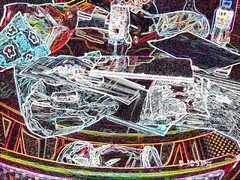I have wanted to put together a succinct piece to explain more about the direction we are moving and why we are making changes.Thank you Will, for pulling it together for me!
I have quoted chunks from his article below but please read it in context.…There is so much there and so much more of value. These parts are just part of my thoughts about the whys?
It is not our Father's Internet- things are changing
Will says…
It's amazing in many ways that in just a few short years, we have gone from a Web that was primarily "read only" to one where creating content is almost as easy as consuming it. One where writing and publishing in the forms of blogs and wikis and podcasts and many other such tools is available to everyone. One where we can connect not just to content but to people and ideas and conversations as well.
The world has/ is changing because technology has changed how we do business and how learn
Will says
This Read/Write Web, or Web 2.0, as some call it, is transforming the traditional structures of many of our most important institutions. How does business change when markets become lively conversations between the consumers who buy their products? What happens to politics when potentially every voter can give immediately direct feedback to elected representatives on important issues, or to journalism when anyone with a wireless camera phone can report on events both large and small?
Think Amazon with consumer reviews or our local Daily News with a call for citizen reporters
It is time to seek a new ways of doing school
Basic skills are important but we need to focus on creating life long learners.
As Will says
Most of us now live in a world where, with access, knowledge is abundant, yet we have yet to reconsider our traditional school model, which is based on the obsolete idea that knowledge is scarce. Take a look at the more than 1,400 courses available at MIT OpenCourseWare (see "Crack the Books,"
September/October 2004), which seeks to "provide free, searchable, access to MIT's course materials for educators, students, and selflearners around the world." It's an amazing array of syllabi, readings, even video lectures from professors that is out there for any of us to tap into, free of charge. It's just one of millions of places where we can learn on the Web, yet most of our students still expect "real" learning to take place only in a classroom.
The tools are available, the students are already using the technologies at home, the missing link is to connect the two and provide mentoring and guidance.
As Will says
This is a world where literacy is changing, where readers need to be editors. Now that anyone can publish just about anything in a heartbeat, checking for facts and relevance often occurs after publication. If you don't believe that, go to MartinLuther- King.org, which comes up in the top ten Google search results for King yet is published by a white-supremacist group and is intended solely to discredit his work through duplicity and falsehoods. (See "Online, on Alert," page 16.) If our students don't know how to find that out, if we ourselves don't know how to do that, I would argue that we are illiterate."
We have a responsibility to become digitally literate and to ensure that all of our students are also.. Teaching digital literacy is perhaps one of our most critical tasks. With the world shrinking before our eyes and our knowledge base continually growing.. our students ability to navigate the world and remain in charge of their own destiny will be dependent upon their abiltity to evaluate information, construct meaning and think critically.
web2.0
education
edutopa
